
Alex Kidd in Miracle World is a platform game for the Master System. It was released in Japan on November 1, 1986, followed by North America in December 1986, with Europe in September 1987, plus South Korea in October 1988, and Brazil in 1989. It was later built into many Master System and Master System II consoles. A remake by Merge Games and Jankenteam, titled Alex Kidd in Miracle World DX, was released on June 22, 2021.

Wonder Boy in Monster Land, known by its original arcade release as Wonder Boy: Monster Land, is a platform video game developed by Westone Bit Entertainment and released by Sega in Japanese arcades in 1987 and for the Master System in 1988, with a number of other home computer and console ports following. The game is the sequel to the 1986 game Wonder Boy and takes place eleven years after the events in the previous game. After enjoying over a decade of peace on Wonder Land following the defeat of the evil King by Tom-Tom, later bestowed the title "Wonder Boy", a fire-breathing dragon called the MEKA dragon appeared; he and his minions conquered Wonder Land, turning it into "Monster Land". The people, helpless due to their lack of fighting skill, call for Wonder Boy, now a teenager, to destroy the monsters and defeat the MEKA dragon. Players control Wonder Boy through twelve linear levels as he makes his way through Monster Land to find and defeat the MEKA dragon. Players earn gold by defeating enemies and buy weapons, armor, footwear, magic, and other items to help along the way.
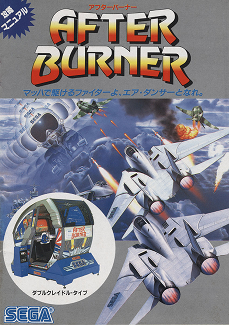
After Burner is a rail shooter arcade video game developed and released by Sega in 1987. The player controls an American F-14 Tomcat fighter jet and must clear each of the game's eighteen unique stages by destroying incoming enemies. The plane is equipped with a machine gun and a limited supply of heat-seeking missiles. The game uses a third-person perspective, as in Sega's earlier Space Harrier (1985) and Out Run (1986). It runs on the Sega X Board arcade system which is capable of surface and sprite rotation. It is the fourth Sega game to use a hydraulic "taikan" motion simulator arcade cabinet, one that is more elaborate than their earlier "taikan" simulator games. The cabinet simulates an aircraft cockpit, with flight stick controls, a chair with seatbelt, and hydraulic motion technology that moves, tilts, rolls and rotates the cockpit in sync with the on-screen action.
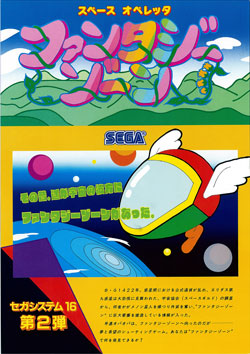
Fantasy Zone is a 1986 arcade video game by Sega, and the first game in the Fantasy Zone series. It was later ported to a wide variety of consoles, including the Master System. The player controls a sentient spaceship named Opa-Opa who fights an enemy invasion in the titular group of planets. The game contains a number of features atypical of the traditional scrolling shooter. The main character, Opa-Opa, is sometimes referred to as Sega's first mascot character.

Streets of Rage 2, known as Bare Knuckle II in Japan, is a 1992 beat 'em up game developed and published by Sega for the Genesis/Mega Drive. A sequel to Streets of Rage (1991), the characters Axel Stone and Blaze Fielding return while the game also introduces two new characters: Max Thunder, and Eddie "Skate" Hunter, the younger brother of Adam Hunter from the first game.

Wonder Boy III: The Dragon's Trap, known as Monster World II in Japan, is a platforming action-adventure video game developed by Westone as part of Sega's Wonder Boy series. It was published by Sega and released for the Master System in 1989 and for the Game Gear in 1992 as Wonder Boy: The Dragon's Trap. It was ported by Hudson Soft and released in 1991 for the TurboGrafx-16/PC Engine under the name Dragon's Curse. It was also ported in 1993 by Brazilian company Tec Toy under the title Turma da Mônica em o Resgate, with the game retooled to include characters from Brazilian comic book series Monica's Gang. A remake developed by Lizardcube and published by DotEmu, titled Wonder Boy: The Dragon's Trap, was released in April 2017.

Castle of Illusion Starring Mickey Mouse is a 1990 platform game developed and published by Sega and released for the Mega Drive/Genesis. An 8-bit version of the game was later released for the Master System and Game Gear. The game follows Mickey Mouse on a quest to save Minnie Mouse from the evil witch Mizrabel. It is the first game in Sega's Illusion video game series starring Mickey.

Fantasia is a side-scrolling video game developed by Infogrames and produced by Sega for its own Mega Drive/Genesis system. The game was loosely based on the film of the same name.
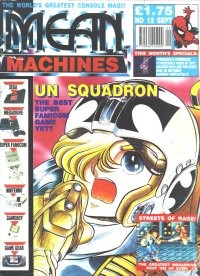
Mean Machines was a multi-format video game magazine published between 1990 and 1992 in the United Kingdom.
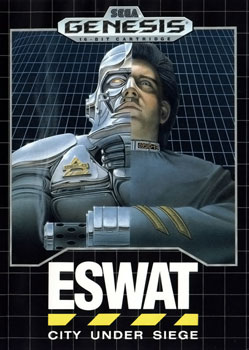
ESWAT: City Under Siege, released in Japan as Cyber Police ESWAT, is a 1990 side scrolling action platform video game developed and published by Sega for the Sega Genesis and Sega Master System video game consoles.

Super Monaco GP is a Formula One racing simulation video game released by Sega, originally as a Sega X Board arcade game in 1989, followed by ports for multiple video game consoles and home computers in the early 1990s. It is the sequel to the 1979 arcade game Monaco GP. The arcade game consists of one race, the Monaco Grand Prix, but later ports added more courses and game modes based on the 1989 Formula One World Championship.

Black Belt is a beat 'em up video game developed and published by Sega for the Master System. The story follows Riki, a martial artist on a mission to save his girlfriend from his rival. Gameplay consists of a series of side-scrolling stages where the player battles waves of minor enemies and the occasional sub-boss. Stages culminate in more challenging boss encounters, each requiring the player to use a specific attack to win.

Strider II, is a 1990 action-platform game published by U.S. Gold and originally released for various computer platforms. It is a European-developed sequel to Capcom's arcade video game Strider, which U.S. Gold previously ported to home computers in Europe.

Galaxy Force is a rail shooter video game developed and released by Sega for arcades in 1988. The player assumes control of a starship named the TRY-Z, as it must prevent the Fourth Empire from taking over the entire galaxy. Gameplay involves shooting down enemies using either a laser shot or a limited supply of heat-seeking missiles, all while avoiding collision with projectiles or obstacles and making sure the ship's energy meter doesn't fully deplete. It ran on the Sega Y Board arcade system, and was released with a motion simulator cockpit arcade cabinet version like previous Sega Super Scaler games.

Fantasy Zone II: The Tears of Opa-Opa is a horizontally scrolling shooter for the Master System published by Sega in 1987. It was ported to the arcade, Famicom, and MSX2, and was remade for the System 16 hardware on a PlayStation 2 compilation in 2008. It was re-released on the Wii Virtual Console in North America on June 29, 2009. Like the first Fantasy Zone, the player controls a sentient spaceship named Opa-opa who fights surreal invader enemies. Like its predecessor, Fantasy Zone II departs from scrolling shooter themes with its bright colors and whimsical designs. For this reason, it is occasionally dubbed a "cute 'em up".
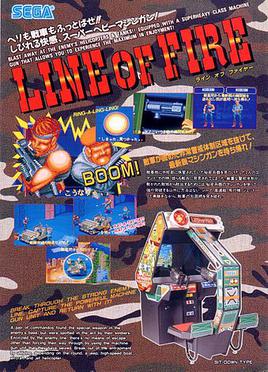
Line of Fire is a first-person light gun shooter game developed by Sega and released for arcades in 1989. It was released with two arcade cabinet versions, a standard upright and a sit-down cockpit, both featuring two positional guns. The cockpit design allows the player(s) to sit down while playing the game, while having two-handed machine guns, controlled by a potentiometer-controlled gun alignment software system. The game follows a two-man commando unit as they try to escape from a terrorist facility after seizing a prototype weapon.

Out Run Europa is a racing video game developed by Probe Software and published by U.S. Gold for the Amiga, Amstrad CPC, Atari ST, Commodore 64, Game Gear, Master System, and ZX Spectrum in 1991. Only the Game Gear version was released in North America. It is a spin-off of Sega's 1986 arcade game Out Run.
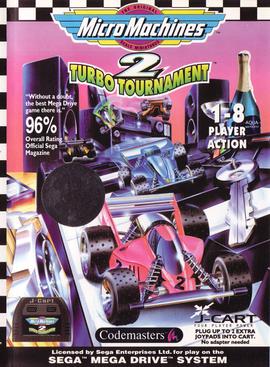
Micro Machines 2: Turbo Tournament is a 1994 racing video game developed by Supersonic Software and published by Codemasters for the Sega Mega Drive. The sequel to Micro Machines, the game is themed around Galoob's Micro Machines toys, and players race around environments in miniature toy vehicles. Micro Machines 2: Turbo Tournament adds new vehicles and game modes, and the Mega Drive version was released on J-Cart, enabling up to eight players without a multitap.

Micro Machines is a racing game developed by Codemasters and originally published by Camerica for the Nintendo Entertainment System in 1991. Themed around Galoob's Micro Machines toys, players race in miniaturised toy vehicles around various environments. The game is the first installment in the Micro Machines video game series.
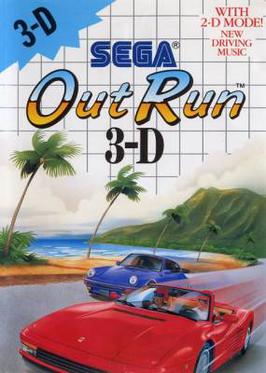
Out Run 3-D is the second of four Out Run racing games developed for the Master System. It was released in 1988. Although based on the original and similar in design, it is a separate game and not a three-dimensional version of the original Out Run.



















